Based just outside Donaghcloney in Co Down, John Beckett, proprietor of Oaklands dairy, milks 140 Holstein cows.
As with most dairy farms, feeding plays a large part in the daily workload aside from milking.
For John, a telescopic handler has a pivotal role in the day-to-day tasks on the farm, clocking up in the region of 1,000 hours annually.
In 2018, the time came for John to upgrade his Terex T200 articulated loader after eight years of service.
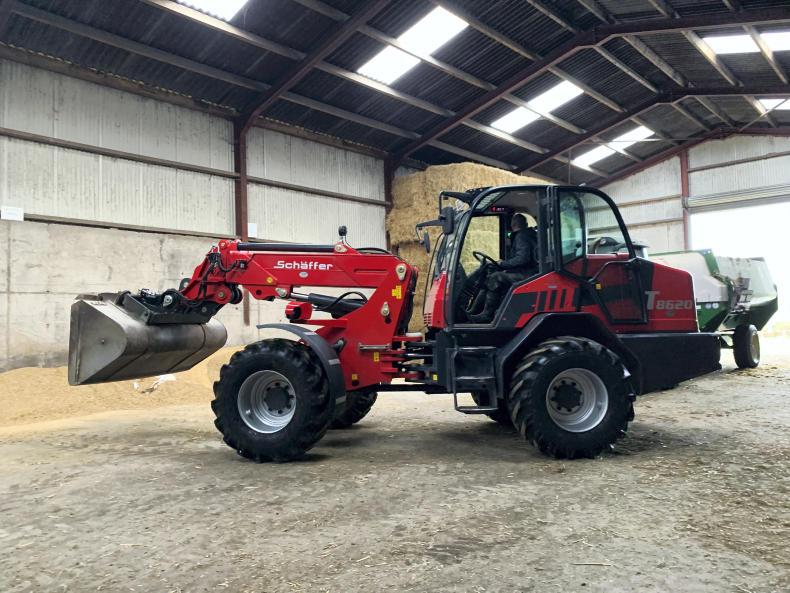
Johns Schaffer 8620T loading his Keenan diet feeder.
“It was time to change the T200. Its boom and articulation points were starting to show signs of wear. It was either trade the machine or spend considerable money refurbishing it, so we decided to trade it,” John said.
He noted he was always fond of the Terex loaders, having had good history with the brand, buying his first Terex back in 1996.
Before buying the Schaffer 8620T, John looked at what a number of other brands were offering in an articulated machine of similar size and power to what he had. The other brands looked at were NC, Weidemann and JCB.
Two things in particular John wanted in a loader were good build quality and backup. Alongside the general tasks of handling dung, loading his diet feeder and fertiliser spreader, he needed something that was still manoeuvrable around the yard. He also needed a loader well capable of pushing up grass during summer.
The Schaffer stood out to John in terms of build quality.
“The strength of the boom and main pivot area on the Schaffer machines was as good as what was on the market at the time.”
Having been in contact with his closest dealer, H Fulton Tractors, a demo 8610T arrived out shortly after. John was well impressed with how the loader performed. At the time, the 8610T model was being replaced with the newly launched 8620T. John decided to opt for 8620T based on what he had seen and liked in the 8610T, with the addition of a three-year warranty swinging him towards buying Schaffer.
So he later took delivery of one of the first 8620Ts in the country.
Engine and transmission
Three Deutz power plants are available in the 8620T – 102hp, 122hp or 136hp. John opted for the 122hp engine. The 3.6l four-cylinder Deutz engine meets Stage IV engine emission standards. Over the 18 months of use since new, John noted that the loader seems fairly good on diesel, albeit harder than his previous Terex but the fact the Schaffer is a larger and more capable may explain why.
Typically John would get four to five tanks of diesel to one tank of Adblue, which is better than what he had initially expected.
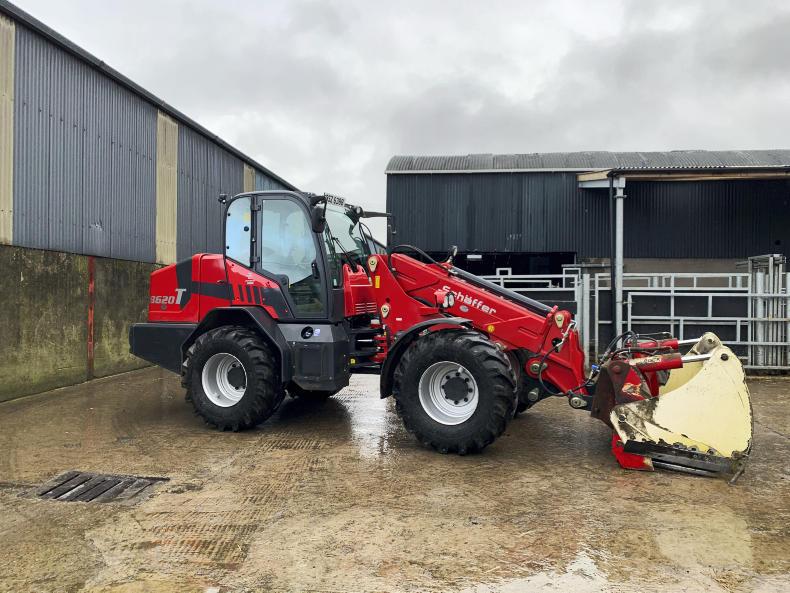
John opted for the larger 136hp engine and 145l/min hydrualic pump.
A major difference in the 8620T and John’s old Terex loader is that the Schaffer is fitted with a 40km/h Danfoss hydrostatic transmission and not a powershift.
“The hydrostatic transmission is a great job and it’s simple to operate. I thought it would take more engine revs to operate it around the yard but you really only need to touch the accelerator.
“There are two ranges, low and high, with an Eco mode to reduce engine rpm travelling the road,” John added. The 40km/h transmission and Eco function is an optional extra in addition to the standard 20km/h box, making 40km/h possible at 1,800rpm.
Hydraulics
John’s 8620T is fitted with the larger hydraulic pump which is a 145l/min swash plate pump. John noted that loader hydraulics are responsive even at low engine revs.
Taking four cuts of 70 acres results in the 8620T clocking up reasonable hours on the silage pit during the summer. John noted that it has proved more than capable of handling his 8ft silage fork so much so that he is considering buying a larger 10ft fork in the near future.
The 8620T has a rated lift capacity of 4,200kg with the boom fully retracted.
“Generally, the straightest lifting we’d be doing is four 600kg fertiliser bags at once and at that the safety system does be beeping.”
The 5.2m boom is fitted with a Z-bar linkage and pin and cone headstock which along with the rest of the boom is built strong in John’s opinion.
The loader is fitted with Dana Spicier HD axles with automatic slip control differentials. The strength of the loader’s main articulation point is a standout feature, John added. The sealed pivot is maintenance-free, he noted, which reduces the number of grease nipples to be regularly greased.

John Beckett, Donaghcloney Co Down.
Cab
Inside the cab is a nice place to be, John noted. “It’s a big improvement from what I moved from. There’s enough room for two people.”
Visibility from the driver’s seat looking forwards and to the sides is good, but the long rear to the machine hinders visibility while reversing, he pointed out. The boom’s main pivot point is lower than some of its competitors, which helps visibility too, he added.
Control layout is clean and simple, with all buttons and switches either located beside the joystick or around the dash. A separate display on the B-pillar shows a flurry of machine info from fuel usage to adblue injection pressure along with other DEF/engine-related data, something John noted that he rarely looks through.
A standout feature he quickly took a liking to was the pressure relief button to remove the hydraulic pressure when engaging or disengaging third service couplings.
“On the old Terex I’d have to turn the engine off and relieve the pressure, whereas this is much handier.”
Alongside air conditioning, the cab has two opening windows, a rare sight on many modern cabs. Although not LED, the loader has a good lighting package, John commented.
The loader’s battery is located under the main step, which John explained is hard accessed as bolts have to be loosened and the step removed to gain access. One other small flaw would be the exposure of the rear tail lights, suggesting that they could have been recessed into the counterweight more.
Verdict
John got the Schaffer in August 2018. Since then, he has clocked up almost 1,300 hours. After getting used to the loader’s larger size, he finds it very manoeuvrable with a good steering lock. “Having changed to a hydrostatic transmission, I couldn’t see myself moving back. Its simplicity to drive and overall abundance of power and build strength has impressed me. Despite a few small flaws, I still think I made the right decision buying a Schaffer,” he said.
P Likes
Build quality.Hydraulic power.Hydrostatic transmission.O Dislikes
Exposed taillights.Access to the battery.Specs
Engine: 122hp (90kW) Deutz 3.6l four-cylinder.
Transmission: Hydrostatic.
Travel speed: 30km/h (40km/h optional).
Hydraulics: 105l/min standard (145l/min optional).
Weight: 7,050kg.
Lift capacity: 4,200kg.
Telescopic reach: 5.2m.
Tyres: 445/65 R22.5.
Fuel & adblue tank capacity: 115l & 20l.
Turning circle: 4.48m.
Selling price: €90,000 plus VAT (spec-dependent).
Based just outside Donaghcloney in Co Down, John Beckett, proprietor of Oaklands dairy, milks 140 Holstein cows.
As with most dairy farms, feeding plays a large part in the daily workload aside from milking.
For John, a telescopic handler has a pivotal role in the day-to-day tasks on the farm, clocking up in the region of 1,000 hours annually.
In 2018, the time came for John to upgrade his Terex T200 articulated loader after eight years of service.

Johns Schaffer 8620T loading his Keenan diet feeder.
“It was time to change the T200. Its boom and articulation points were starting to show signs of wear. It was either trade the machine or spend considerable money refurbishing it, so we decided to trade it,” John said.
He noted he was always fond of the Terex loaders, having had good history with the brand, buying his first Terex back in 1996.
Before buying the Schaffer 8620T, John looked at what a number of other brands were offering in an articulated machine of similar size and power to what he had. The other brands looked at were NC, Weidemann and JCB.
Two things in particular John wanted in a loader were good build quality and backup. Alongside the general tasks of handling dung, loading his diet feeder and fertiliser spreader, he needed something that was still manoeuvrable around the yard. He also needed a loader well capable of pushing up grass during summer.
The Schaffer stood out to John in terms of build quality.
“The strength of the boom and main pivot area on the Schaffer machines was as good as what was on the market at the time.”
Having been in contact with his closest dealer, H Fulton Tractors, a demo 8610T arrived out shortly after. John was well impressed with how the loader performed. At the time, the 8610T model was being replaced with the newly launched 8620T. John decided to opt for 8620T based on what he had seen and liked in the 8610T, with the addition of a three-year warranty swinging him towards buying Schaffer.
So he later took delivery of one of the first 8620Ts in the country.
Engine and transmission
Three Deutz power plants are available in the 8620T – 102hp, 122hp or 136hp. John opted for the 122hp engine. The 3.6l four-cylinder Deutz engine meets Stage IV engine emission standards. Over the 18 months of use since new, John noted that the loader seems fairly good on diesel, albeit harder than his previous Terex but the fact the Schaffer is a larger and more capable may explain why.
Typically John would get four to five tanks of diesel to one tank of Adblue, which is better than what he had initially expected.

John opted for the larger 136hp engine and 145l/min hydrualic pump.
A major difference in the 8620T and John’s old Terex loader is that the Schaffer is fitted with a 40km/h Danfoss hydrostatic transmission and not a powershift.
“The hydrostatic transmission is a great job and it’s simple to operate. I thought it would take more engine revs to operate it around the yard but you really only need to touch the accelerator.
“There are two ranges, low and high, with an Eco mode to reduce engine rpm travelling the road,” John added. The 40km/h transmission and Eco function is an optional extra in addition to the standard 20km/h box, making 40km/h possible at 1,800rpm.
Hydraulics
John’s 8620T is fitted with the larger hydraulic pump which is a 145l/min swash plate pump. John noted that loader hydraulics are responsive even at low engine revs.
Taking four cuts of 70 acres results in the 8620T clocking up reasonable hours on the silage pit during the summer. John noted that it has proved more than capable of handling his 8ft silage fork so much so that he is considering buying a larger 10ft fork in the near future.
The 8620T has a rated lift capacity of 4,200kg with the boom fully retracted.
“Generally, the straightest lifting we’d be doing is four 600kg fertiliser bags at once and at that the safety system does be beeping.”
The 5.2m boom is fitted with a Z-bar linkage and pin and cone headstock which along with the rest of the boom is built strong in John’s opinion.
The loader is fitted with Dana Spicier HD axles with automatic slip control differentials. The strength of the loader’s main articulation point is a standout feature, John added. The sealed pivot is maintenance-free, he noted, which reduces the number of grease nipples to be regularly greased.

John Beckett, Donaghcloney Co Down.
Cab
Inside the cab is a nice place to be, John noted. “It’s a big improvement from what I moved from. There’s enough room for two people.”
Visibility from the driver’s seat looking forwards and to the sides is good, but the long rear to the machine hinders visibility while reversing, he pointed out. The boom’s main pivot point is lower than some of its competitors, which helps visibility too, he added.
Control layout is clean and simple, with all buttons and switches either located beside the joystick or around the dash. A separate display on the B-pillar shows a flurry of machine info from fuel usage to adblue injection pressure along with other DEF/engine-related data, something John noted that he rarely looks through.
A standout feature he quickly took a liking to was the pressure relief button to remove the hydraulic pressure when engaging or disengaging third service couplings.
“On the old Terex I’d have to turn the engine off and relieve the pressure, whereas this is much handier.”
Alongside air conditioning, the cab has two opening windows, a rare sight on many modern cabs. Although not LED, the loader has a good lighting package, John commented.
The loader’s battery is located under the main step, which John explained is hard accessed as bolts have to be loosened and the step removed to gain access. One other small flaw would be the exposure of the rear tail lights, suggesting that they could have been recessed into the counterweight more.
Verdict
John got the Schaffer in August 2018. Since then, he has clocked up almost 1,300 hours. After getting used to the loader’s larger size, he finds it very manoeuvrable with a good steering lock. “Having changed to a hydrostatic transmission, I couldn’t see myself moving back. Its simplicity to drive and overall abundance of power and build strength has impressed me. Despite a few small flaws, I still think I made the right decision buying a Schaffer,” he said.
P Likes
Build quality.Hydraulic power.Hydrostatic transmission.O Dislikes
Exposed taillights.Access to the battery.Specs
Engine: 122hp (90kW) Deutz 3.6l four-cylinder.
Transmission: Hydrostatic.
Travel speed: 30km/h (40km/h optional).
Hydraulics: 105l/min standard (145l/min optional).
Weight: 7,050kg.
Lift capacity: 4,200kg.
Telescopic reach: 5.2m.
Tyres: 445/65 R22.5.
Fuel & adblue tank capacity: 115l & 20l.
Turning circle: 4.48m.
Selling price: €90,000 plus VAT (spec-dependent).






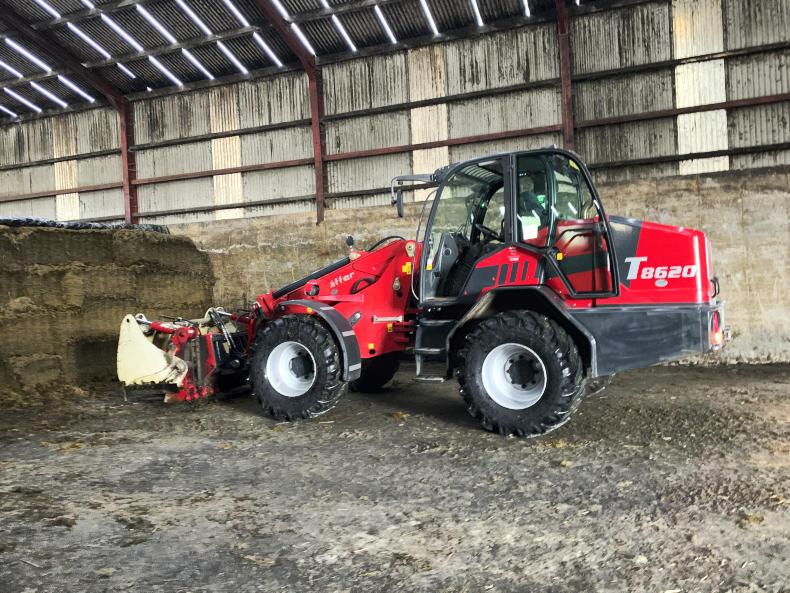

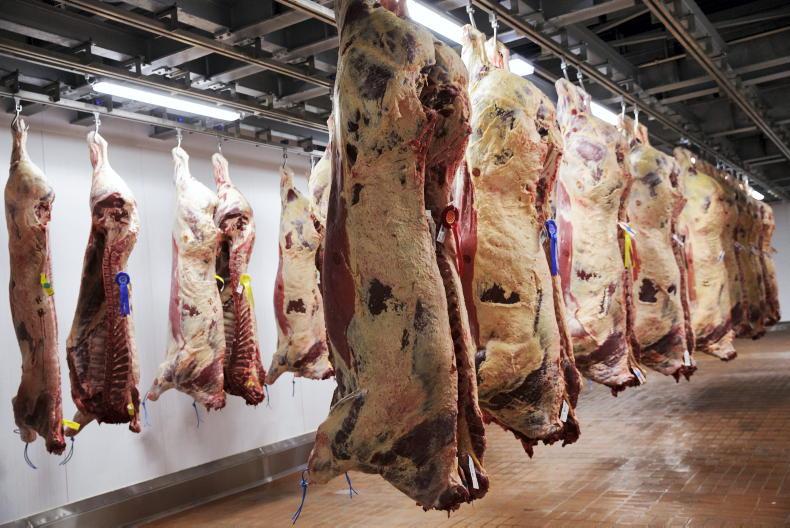

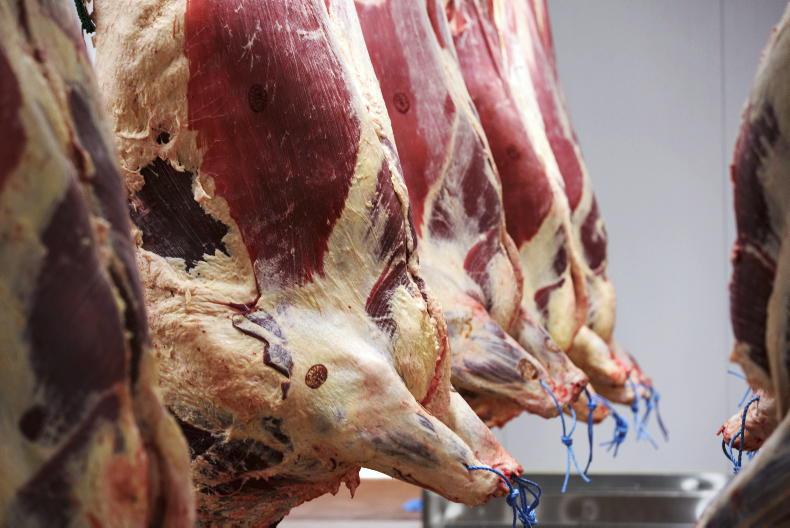


SHARING OPTIONS